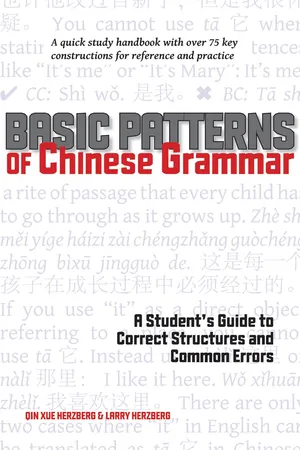CHAPTER ONE
Word order
(1) Basic word order
The basic word order in English is Who, What, Where, When. The basic word order in Chinese is Who, When, Where, What.
English: We ate lunch at McDonald’s at 1:00 yesterday afternoon.
Chinese: We yesterday afternoon at 1:00 at McDonald’s ate lunch.
Wǒmen zuótiān xiàwǔ yìdiǎn zhōng zài Màidāngláo chīle wǔfàn.
我们昨天下午一点钟在麦当劳 吃了午饭。
English: We saw a Chinese movie at that movie theater Saturday evening.
Chinese: We Saturday evening at that movie theater saw a Chinese movie.
Wǒmen xīngqīliù wǎnshang zài nàge diànyǐngyuàn kànle yíge Zhōngguó diànyǐng.
我们星期六晚上在那个电影院看了一个中国电影。
(2) Action and location: someone does something somewhere
English: Who, what, where, (when)
Chinese: Who, (when) where, what
English: I eat dinner at home.
Chinese: I at home eat dinner .
Wǒ zài jiāli chī wǎnfàn.
我在家里吃晚饭。
English: I study in the library.
Chinese: I at the library study.
Wǒ zài túshūguǎn niànshū.
我在图书馆念书。
(3) Action and time: when somebody does something
English: Who, what, (where) when
Chinese: Who, when, (where) what
The time WHEN something happens always comes before the verb.
English: I get up at 8:00.
Chinese: I at 8:00 get up.
Wǒ bādiǎn zhōng qǐchuáng.
我八点钟起床。
English: I eat breakfast at 8:30.
Chinese: I at 8:30 eat breakfast.
Wǒ bādiǎn bàn chī zǎofàn.
我八点半吃早饭。
(4) Word order for expressing WHEN something happened
The biggest, most general time words come first in Chinese:
English: day, month, year
Chinese: year, month, day
English: Saturday, October 1, 1949 (Founding of the PRC)
Chinese: 1949, October 1, Saturday
Yījiǔsìjiǔnián, shíyuè yíhào, xīngqīliù
1949年10月1日,星期六。
English: 8:00 a.m. on July 4, 1820 (America’s First Independence day)
Chinese: 1820, July 4, at 8:00 a.m.
Yībāèrlíngnián qīyuè sìhào, zǎoshang bādiǎn zhōng.
1820年7月4日,早上八点钟。
(5) Word order for duration of time: how long someone did something
The word order for expressing the length or duration of time is very different from expressing the time when an action occurred. Here, the length of time of an action can come at the end of the sentence, whereas this can NEVER happen with expressing WHEN something occurred.
I slept eight hours of sleep.
Wǒ shuìle bāge zhōngtou (xiǎoshí) de jiào.
我睡了八个钟头 (小时) 的觉。
OR, if you are stating t...
